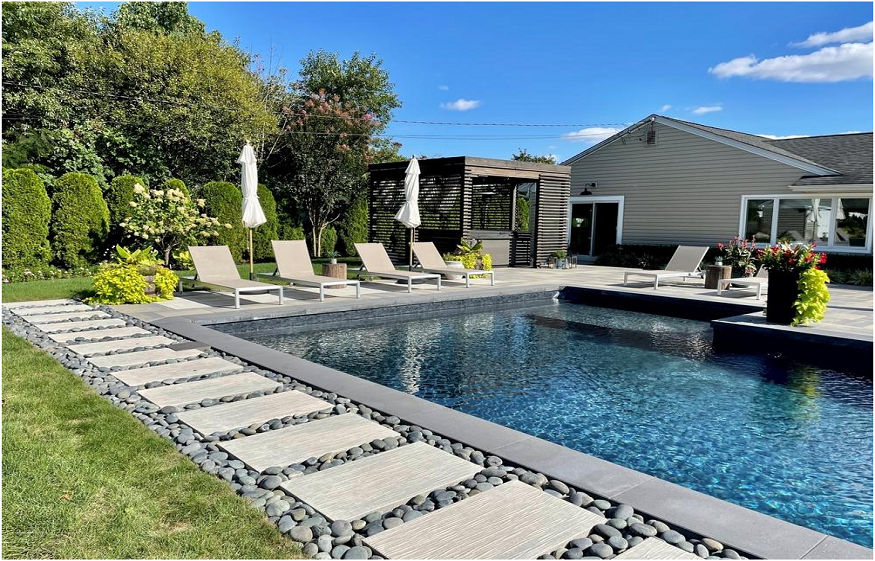When it comes to inground swimming pools, vinyl pool liners are a popular and budget-friendly option for homeowners. They offer a customizable, smooth finish and are relatively quick to install compared to other types of pool surfaces like concrete or fiberglass. Whether you’re building a new pool or replacing an old liner, understanding the features, benefits, and maintenance needs of vinyl liners is essential. This article covers everything you need to know about vinyl pool liners—from types and installation to lifespan and cost.
What Is a Vinyl Pool Liner?
A vinyl pool liner is a flexible membrane made from durable vinyl material that fits the inside contours of an inground pool.
They are often chosen for their affordability, easy customization, and smooth surface that is gentle on skin and swimwear.
Types of Vinyl Pool Liners
There are two primary types of vinyl pool liners:
- Overlap Liners
Overlap liners are more common in above-ground pools but can be used in certain inground pool situations. They are more affordable but offer less precision in fit.
-
Beaded Liners
This provides a more secure and precise fit.
Benefits of Vinyl Pool Liners
- Cost-Effective
They offer a lower upfront investment, making them ideal for budget-conscious homeowners.
- Customizable Design
Vinyl liners come in various patterns, colors, and textures, allowing homeowners to achieve a personalized look.
- Quick Installation
Most installations can be completed within a few days, making them ideal for projects with tight timelines.
Installation Process
Installing a vinyl liner involves several key steps:
- Pool Structure Setup
The base structure, typically made of steel or polymer walls, is assembled and secured into the excavated area.
- Floor Preparation
The pool floor is smoothed and prepped using materials like sand or a concrete vermiculite mix to provide a level base.
- Liner Placement
Air vacuums are used to remove wrinkles and ensure a tight fit.
- Water Fill and Final Adjustments
As the pool fills with water, the liner continues to settle. Installers make adjustments to ensure a smooth surface and finish the plumbing connections and trim pieces.
Lifespan and Durability
- Water chemistry balance
- UV exposure
- Pool usage frequency
- Proper maintenance
- Liner thickness (mil rating)
Thicker liners (20-30 mil) tend to last longer and are more resistant to tears and punctures. While vinyl is strong, it’s not immune to damage. Sharp objects, improper cleaning tools, or excessive sun exposure can shorten its lifespan.
Maintenance Tips
- Keep Water Chemistry Balanced
Unbalanced water can degrade vinyl over time. Regularly test and adjust pH, chlorine, and alkalinity levels to maintain a safe and liner-friendly environment.
- Clean with Non-Abrasive Tools
Use brushes and vacuums specifically designed for vinyl pools. Avoid stiff-bristle brushes or harsh chemicals that could scratch or damage the surface.
- Watch for Leaks
Vinyl liners can develop leaks or tears. Monitor water levels regularly, and inspect for soft spots or discoloration that may signal a problem.
4. Cover the Pool
Use a pool cover when the pool is not in use to protect the liner from UV damage and debris.
When to Replace a Vinyl Pool Liner
- Fading or discoloration
- Cracks or tears
- Wrinkling or stretching
- Persistent water loss
- Brittle texture
Replacing a liner is a significant part of ongoing pool ownership, but choosing a high-quality replacement and professional installation can extend the pool’s usability for years to come.
Cost Overview
New vinyl liner pool installations (including structure and materials) usually range from $35,000 to $60,000.
While initial costs are lower than other pool types, remember to factor in periodic liner replacements every 7–12 years when planning long-term expenses.
Conclusion
Indianapolis vinyl pool liners offer a practical, attractive, and budget-friendly option for homeowners looking to build or renovate an inground pool. With a wide range of design options and a relatively quick installation process, vinyl liners are ideal for those seeking flexibility and comfort. By understanding the types, benefits, and maintenance needs of vinyl liners, you can make informed decisions that lead to a beautiful and long-lasting backyard retreat.

